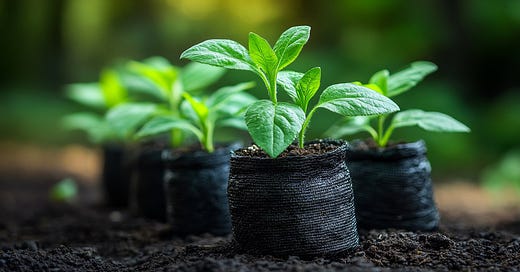“Do not despise these small beginnings, for the Lord [and probably every decent coach, ever] rejoices to see the work begin.”
— Zechariah 4:10
The Black Cloak and the Fruit Tree
While writing Habits for Leaders, two images kept showing up:
the monk’s cloak and the apple tree.
Monks wear something called a habit—a literal piece of clothing. But more than that, they live their habits. Silent meals. Early bells. Prayers at dawn. It’s not hype. It’s rhythm. And over time, that rhythm forms something deeper.
Apple trees? Same story.
They don’t force growth. They don’t will fruit into existence. They just keep sinking their roots deep, soaking up light, staying grounded in their place. And, season after season, the fruit shows up—on time, without striving.
These two images remind me:
Transformation isn’t about intensity. It’s about consistency.
It doesn’t come from heroic effort.
It comes from daily rhythm.
Your Habits Are Already Speaking
You don’t have to take a vow or shave your head to follow a Rule of Life.
You already have one.
Your morning routine. The way you scroll. What you do after work. When and how you move your body. These patterns are preaching something to your brain, your body, your relationships.
Whether you've named them or not, your habits are forming you.
So ask yourself:
What do your current habits reflect?
What do they reinforce?
What do they resist?
Because habits aren’t just behaviors.
They’re identity signals.
As Ralph Waldo Emerson said:
“Sow a thought and you reap an act; sow an act and you reap a habit; sow a habit and you reap a character…”
And more recently, James Clear put it like this:
“Every action you take is a vote for the type of person you wish to become.”
The Neuroscience of Formation
Here’s where the science backs up the monks.
According to researcher Wendy Wood, new habits don’t require heroic willpower. They require:
Context – An environment that reduces friction and sets you up for success.
Repetition – Cues and rhythms that make consistency possible.
Reward – Meaningful reinforcement that connects your habit to purpose.
This isn’t just behavior change.
It’s neuroplasticity—your brain reshaping itself through practice.
In spiritual terms: formation by muscle memory.
In leadership terms: growth through rhythm, not grind.
What the Ancients Already Knew
Long before neuroscience had a name for it, ancient teachers had already charted the path.
Aristotle said, “We are what we repeatedly do. Excellence, then, is not an act, but a habit.” So, we become just by doing just acts, courageous by doing courageous acts.
The Desert Fathers retreated into the wilderness, not to escape, but to cultivate patterns of simplicity, stillness, and prayer that slowly reshaped them from the inside out.
Dallas Willard though not an ancient, tugged together ancient ideas when drafting his Reliable Pattern: Vision → Intention → Means. We need to clearly see who we want to become, choose it intentionally, and then use the right tools to make it real.
Your life isn’t changed by a New Year’s resolution.
It’s changed by the 9pm decision to plug in your phone in another room.
By the 5-minute journaling habit that recalibrates your priorities.
By choosing silence before meetings, instead of more input.
Transformative change comes through practice/s. From seeing the life you long to live, choosing it, and then walking it out one small act at a time.
The Habits We Wear
Think of your current rhythms:
The morning scan of emails
The stories you repeat to yourself in moments of stress
The second cup of coffee before interaction
The family dinner, rushed or unrushed
The way your meetings begin—or don’t
Each is a thread in the cloak you wear. Each forms your habits of attention, your presence, your posture toward others, your default responses in pressure moments.
Want to change your leadership? Change your habits.
Want to lead from your values? Name them, then pattern them.
Five Small Shifts That Create Big Change
Stack something good
Pair a new practice with an existing one (e.g., Lay out walking shoes beside your bed. Silence before meetings).Shrink the habit
Start embarrassingly small. 1 push-up. 1 sentence. Consistency matters more than volume.Connect to vision
Don’t run to run. Run for energy, for presence, for peace. Align each habit to your why—health for presence, margin for creativity, clarity for wise decisions.Make the context work for you
Rearrange your environment. Create visual cues. Lower friction. Set the scene for success.Expect resistance, not perfection
You’re not failing when it’s hard. You’re forming. Miss a day? Try again. Guilt is a terrible coach. Grace is better.
The Invitation
What’s the smallest shift you could make this week that supports who you want to become?
You don’t need to become a monk.
But you might need to borrow their clarity.
Reflect & Respond
What identity are your current habits reinforcing?
What’s the fruit you want to grow?
What’s one small act of alignment you could take—today?
What’s the vision you’re building your life around?
Want to Go Deeper?
Explore more in the Habits for Leaders book (20 practical rhythms that support everyday leadership), or walk—a set of seven DIY coaching sessions designed to align your vision, values, and practices for a structured path toward deeper alignment.
Also free: the Resist Drift reflection guide to help you pause and reset.
✢ Everyday Formation Sanity-saving practices for busy souls.
Soul formation that fits actual life—no sabbatical required. If you’re still reading, you may already be a Waykeeper. Or just someone who procrastinates by reading long articles about email. Either way, you’re in good company. Subscribe for less hustle, more hope, and the occasional sarcastic benediction.
No spam. No dance tutorials. Just grounded wisdom, “becoming” banter, and the occasional Chesterton quote. Subscribe to stay steady. Invite a friend. Let’s keep walking.
Explore more tools and resources → groundedandgrowing.carrd.co




